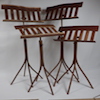Good afternoon folks!
Here is my query:
I am currently considering buying a vintage drill press in excellent/near mint condition that was likely designed for metal work. It is a Van Dorn (later Black and Decker), 1 hp/25 amp 220v motor with fixed RPM at 900.
I have the ability to make a hold down jig for stock to use as a hollow chisel mortiser.
What are your thoughts on this? Is 900 rpm enough spindle speed for that usage? ( I see that most of the modern machines are 1725).
I cannot see paying $$$$$! for a Powermatic made in Taiwan that does not even have the capacity to mortise timbers like I will be using (old barn beams, etc.)
Would appreciate any input!
John




 Reply With Quote
Reply With Quote



